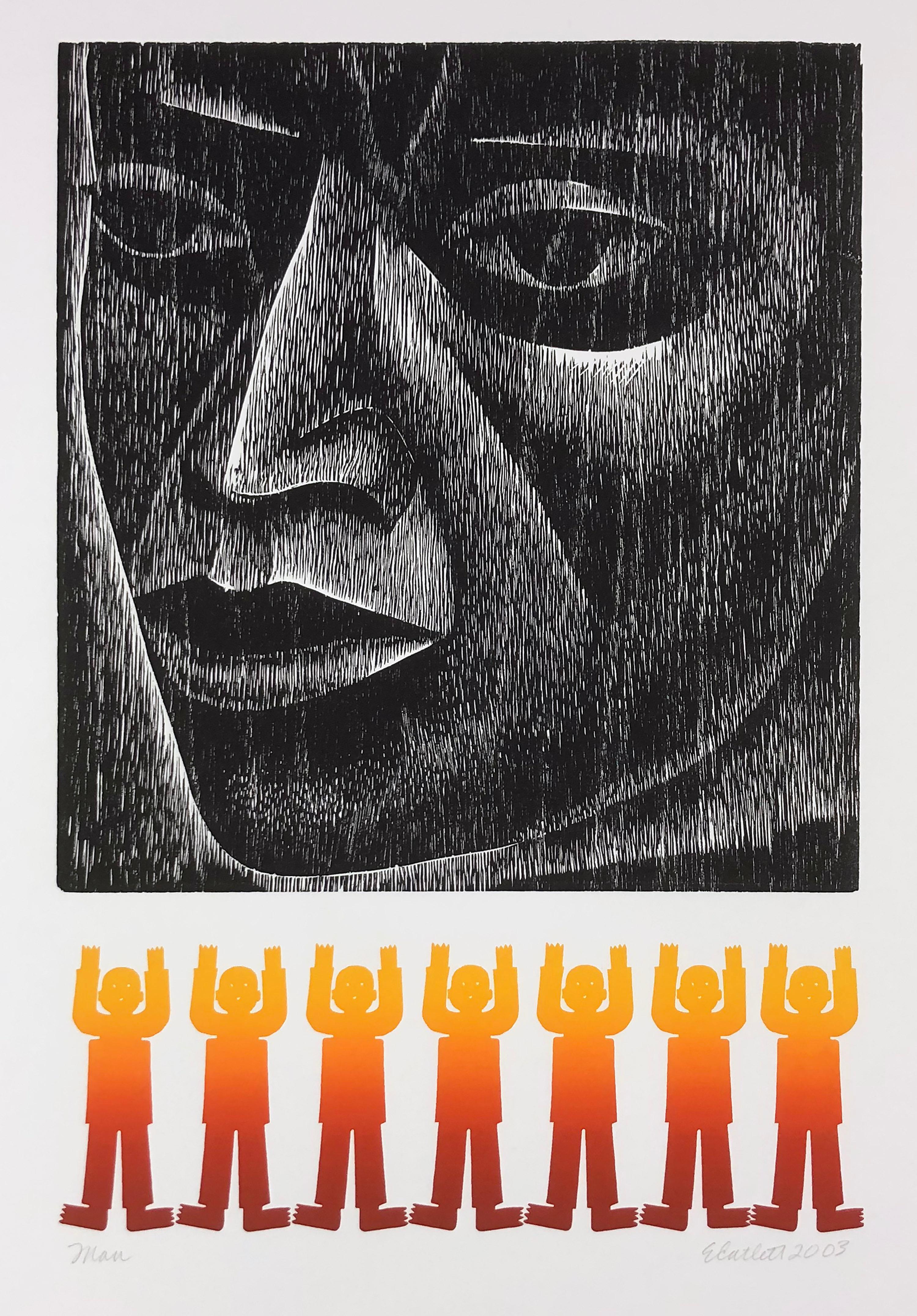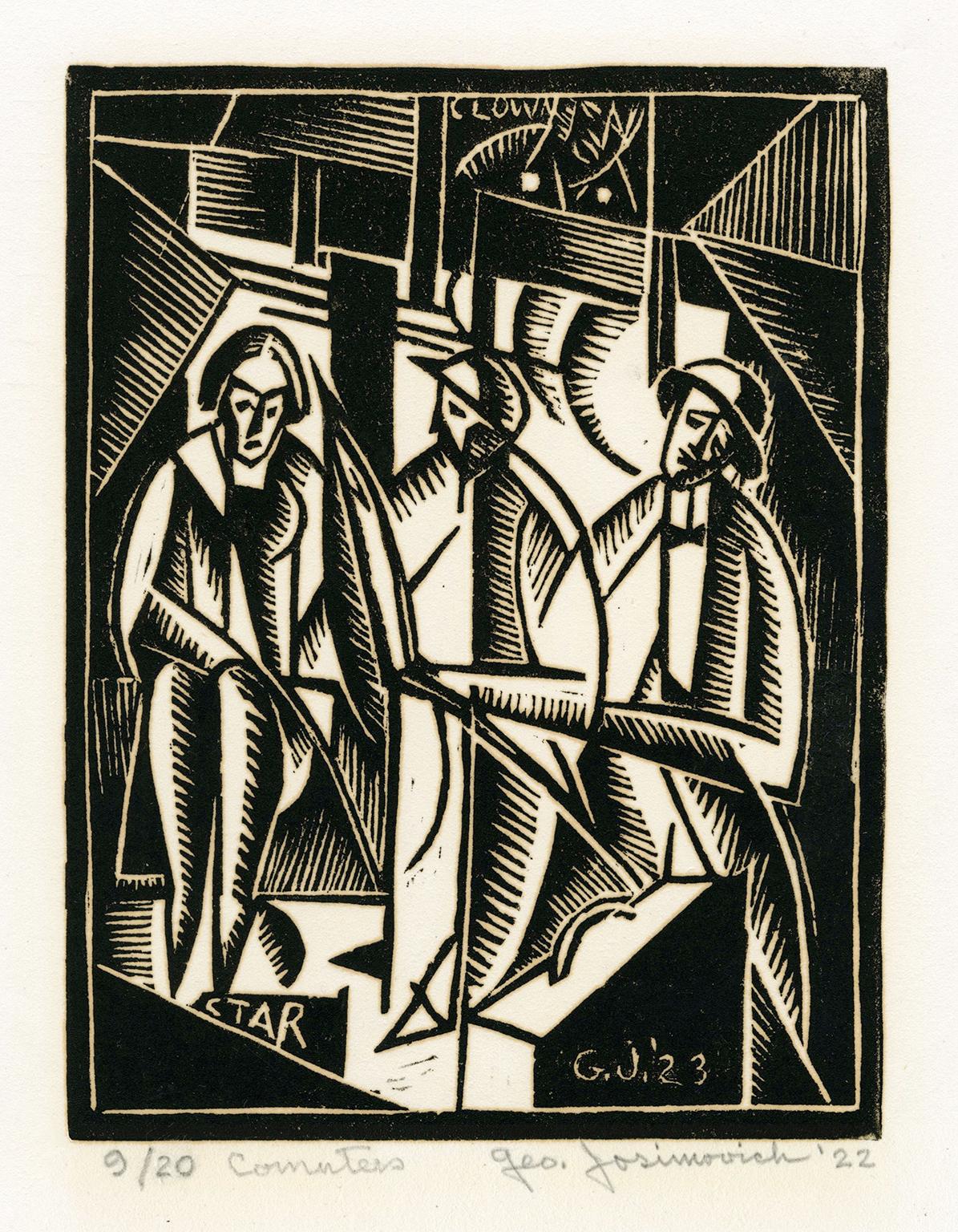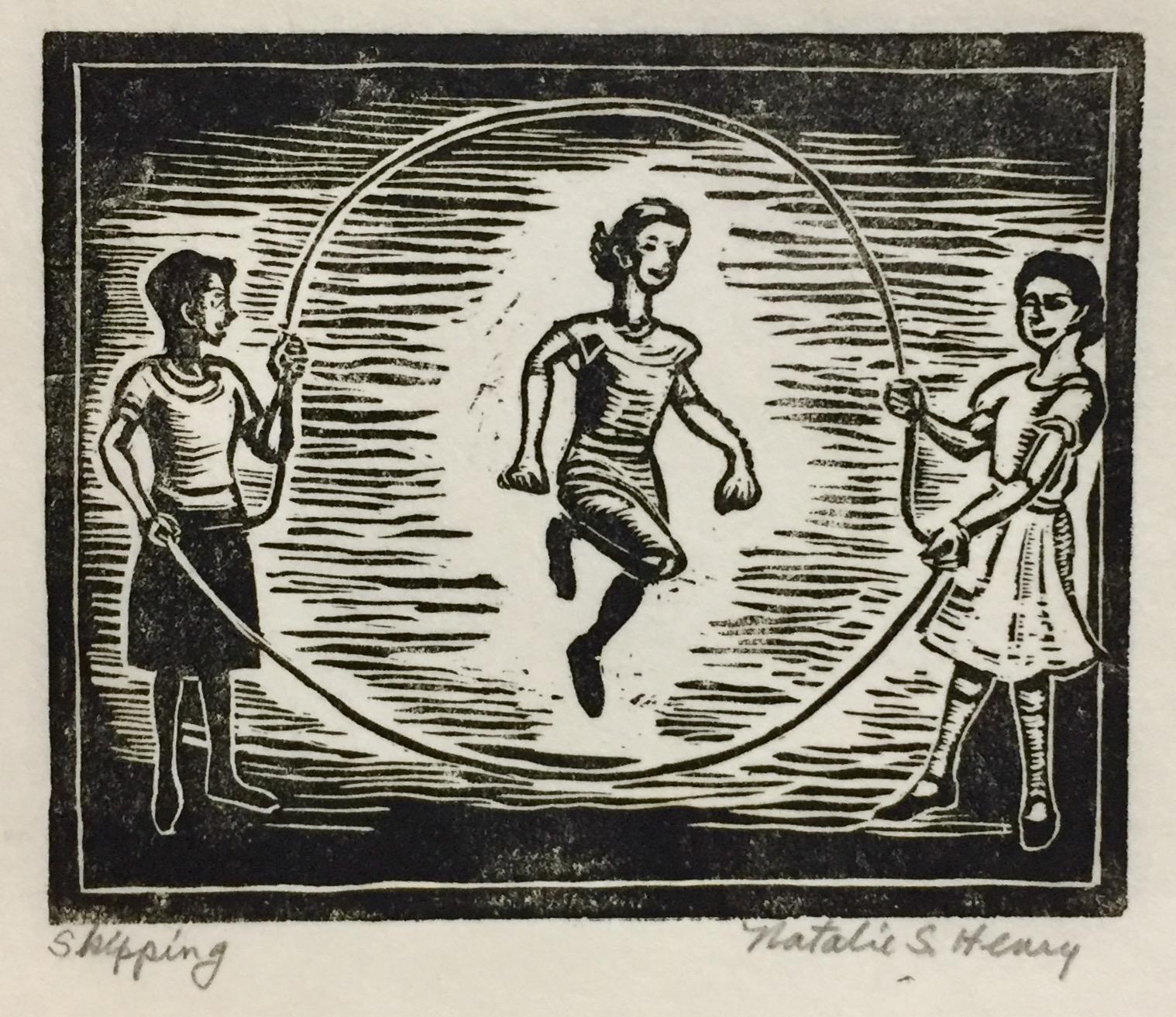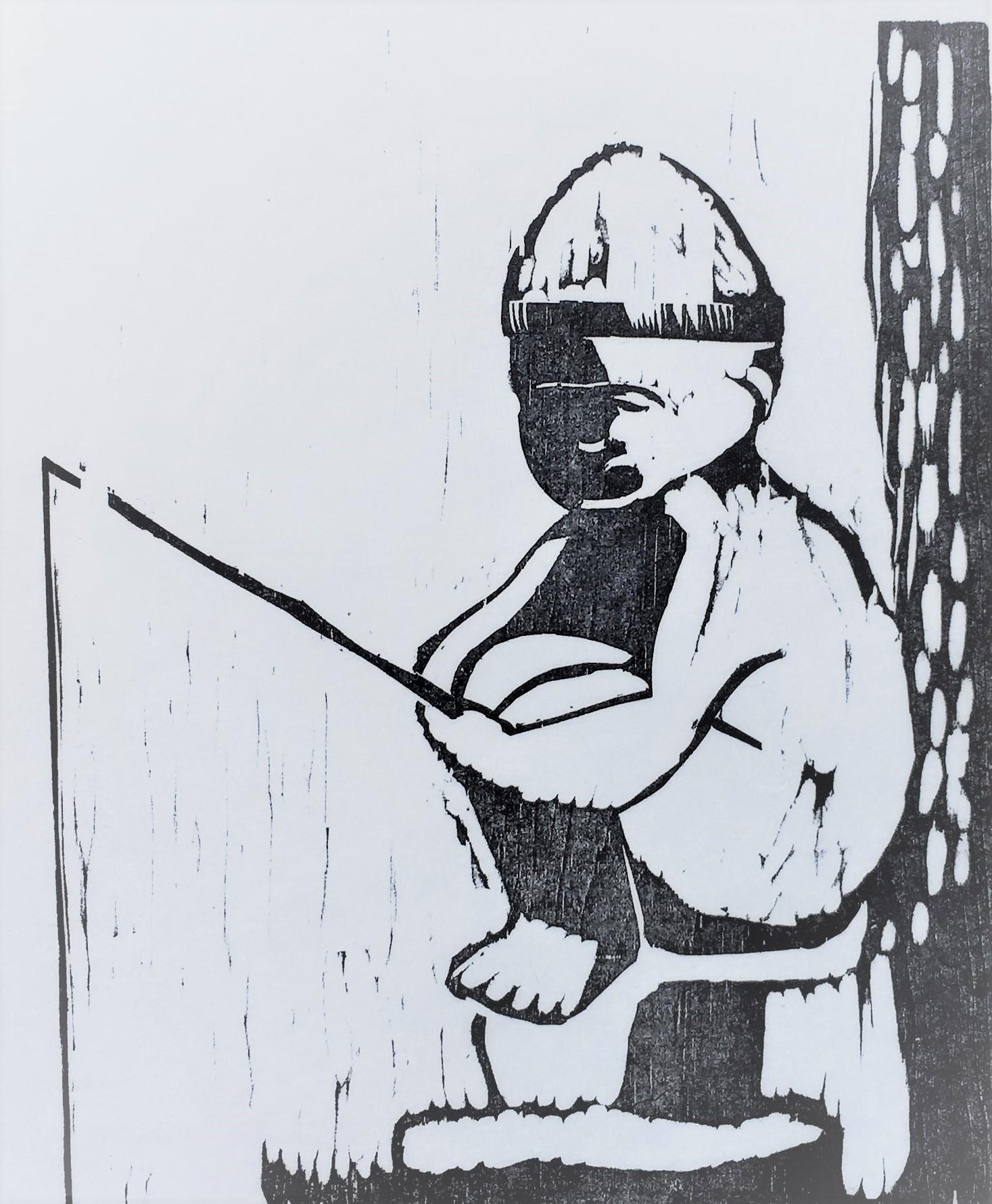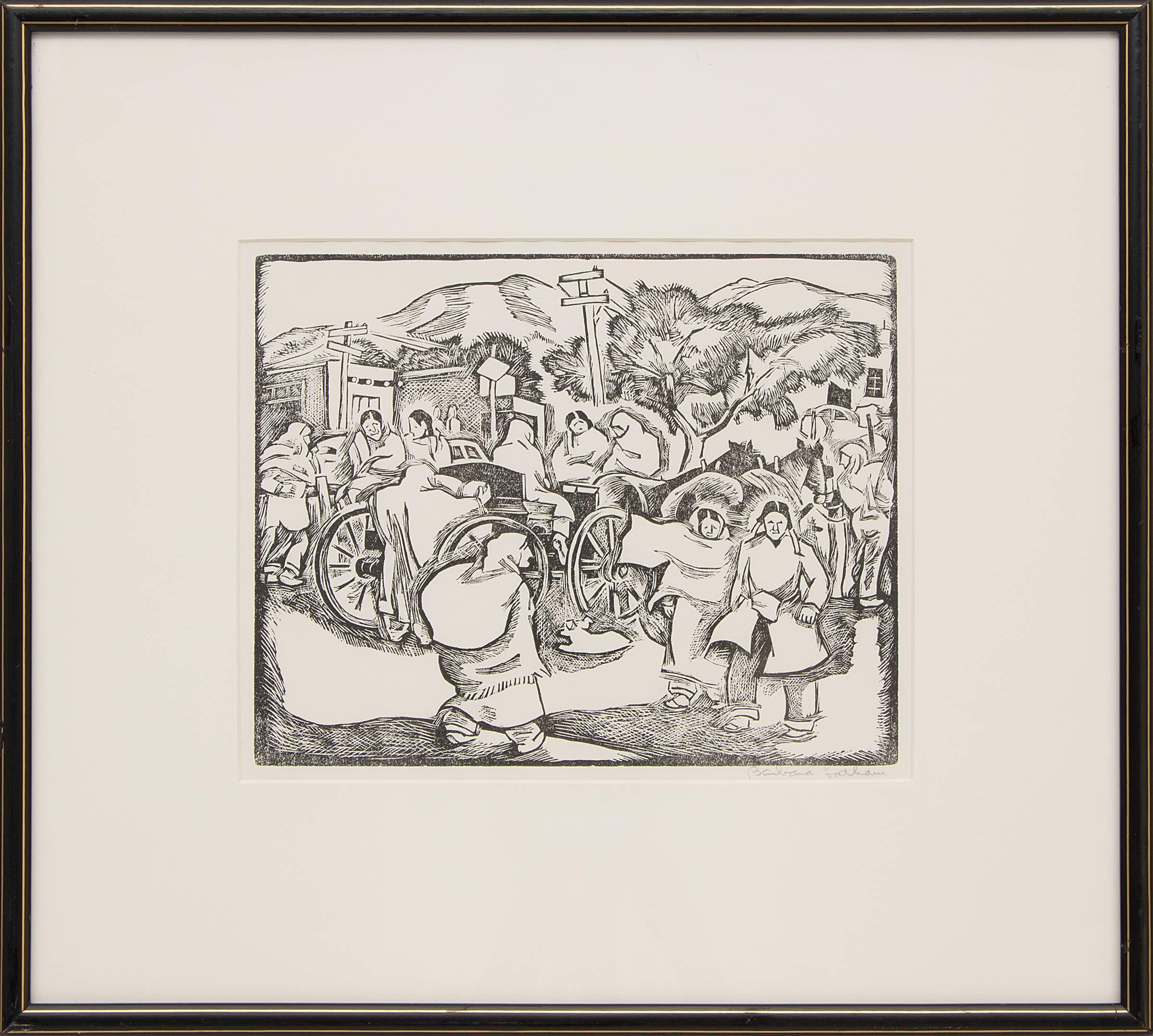Items Similar to FRUIT FOR SALE
Want more images or videos?
Request additional images or videos from the seller
1 of 5
Frances H. GearhartFRUIT FOR SALE1928
1928
About the Item
FRANCES H. GEARHART and Sisters (THE GEARHARTS)
FRUIT FOR SALE c.1928
Color block print. Unsigned. This is an original block print from “Let’s Play”, an intended but unpublished children’s book done in collaboration with her sisters Edna and May in 1928. Image 8 x 7 inches. On a tissue thin laid paper. Irregular sheet 9 3/8 x 8 1/2. The entire series consisted of over 20 children's images.
There were very few printed. The editions of the various children varied but likely no more than 50. This impression very well printed with good colors, Very good condition. The margins are likely as issued with the irregular edges. The margins and paper used for this series varies from one print to the next. A bit of tape remnants at top center sheet edge. A very nice example of this print.
It is not unusual for impressions of this series to be unsigned, although many are signed "The Gearharts"
The Provenance of this example is fascinating. It was acquired from a gentleman who knew the Gearharts as a child in the early 50's in Pasadena. It was part of a collection given to him by Frances. In his adult years he was in the military and took the collection with him as he traveled around Europe,
After 81 years, based on the original prints, this book was published by
the “California Book Club” in a limited edition of 1000 in 2009
Color woodcut, Arts and Crafts, Children's Illustration, California Art.
- Creator:Frances H. Gearhart (1869 - 1958, American)
- Creation Year:1928
- Dimensions:Height: 8 in (20.32 cm)Width: 7 in (17.78 cm)
- Medium:
- Movement & Style:
- Period:
- Condition:
- Gallery Location:Santa Monica, CA
- Reference Number:1stDibs: LU41138475212
About the Seller
5.0
Recognized Seller
These prestigious sellers are industry leaders and represent the highest echelon for item quality and design.
Platinum Seller
These expertly vetted sellers are 1stDibs' most experienced sellers and are rated highest by our customers.
Established in 1977
1stDibs seller since 2016
267 sales on 1stDibs
Typical response time: <1 hour
Associations
International Fine Print Dealers Association
- ShippingRetrieving quote...Ships From: Santa Monica, CA
- Return PolicyA return for this item may be initiated within 7 days of delivery.
More From This SellerView All
- THE RUG WEAVERBy Gustave BaumannLocated in Santa Monica, CAGUSTAVE BAUMANN (1881 – 1971) THE RUG WEAVER, 1910 (Chamberlain 26) Color woodcut signed in pencil. Unnumbed from an edition 100 as published in the Hills o’ Brown...Category
1910s American Modern Figurative Prints
MaterialsWoodcut
- VILLAGE SCENE / TOWN FESTIVALBy Herbert GurschnerLocated in Santa Monica, CAHERBERT GURSCHNER (Austrian / English (1901-1975) VILLAGE SCENE / TOWN FESTIVAL ca.1924 Color woodcut 4 ¾ x 5 3/8” Signed in pencil. Good strong colors. On thin paper. Faint darkeni...Category
1920s Modern Figurative Prints
MaterialsWoodcut, Linocut
- Circus Girl With Plumed HatBy Yasuo KuniyoshiLocated in Santa Monica, CAYASUO KUNIYOSHI (1893 -1957) CIRCUS GIRL WITH PLUMED HAT, 1933 (D.L60) Lithograph, signed in pencil and annotated 25P (edition of 25). Image 12 5/8 x 9 3/8 inches. Full margins w...Category
1930s American Modern Figurative Prints
MaterialsLithograph
- A Winter - Seeming Summers NightBy June WayneLocated in Santa Monica, CAJUNE WAYNE (1918 - 2011) A WINTER - SEEMING SUMMER'S NIGHT, 1957 From the John Donne Series. (Conway 122, Basket 106: Gilmour 50) Lithograph signed, title...Category
1950s American Modern Figurative Prints
MaterialsLithograph
- Tamas The Power of BadBy Willy PoganyLocated in Santa Monica, CAWILLY POGANY (1882 - 1955) TAMAS THE POWER OF BAD, c. 1940. Etching, signed and titled and numbered 50 in pencil. Image 12 x 9 inches. Sheet 14 7/8 x 10 3/4 inches. Generally goo...Category
1940s American Modern Figurative Prints
MaterialsEtching
- Comanche PortraitBy Charles Banks WilsonLocated in Santa Monica, CACHARLES BANKS WILSON (American 1918 - 2013) COMANCHE PORTRAIT, c. 1941 Lithograph signed in pencil. Edition 250 as published by Associated Artists. 10 1/4 x 14 1/2 inches. Sheet, 1...Category
1940s American Modern Figurative Prints
MaterialsLithograph
You May Also Like
- ManBy Elizabeth CatlettLocated in Missouri, MOElizabeth Catlett “Man” 1975 (The Print Club of Cleveland Publication Number 83, 2005) Woodcut and Color Linocut Printed in 2003 at JK Fine Art Editions Co., Union City, New Jersey Signed and Dated By The Artist Lower Right Titled Lower Left Ed. of 250 Image Size: approx 18 x 12 inches Elizabeth Catlett (1915-2012) is regarded as one of the most important women artists and African American artists of our time. She believed art could affect social change and that she should be an agent for that change: “I have always wanted my art to service black people—to reflect us, to relate to us, to stimulate us, to make us aware of our potential.” As an artist and an activist, Catlett highlighted the dignity and courage of motherhood, poverty, and the working class, returning again and again to the subject she understood best—African American women. The work below, entitled, “Man”, is "carved from a block of wood, chiseled like a relief. Catlett, a sculptor as well as a printmaker, carves figures out of wood, and so is extremely familiar with this material. For ‘Man’ she exploits the grain of the wood, allowing to to describe the texture of the skin and form vertical striations, almost scarring the image. Below this intense, three-dimensional visage parades seven boys, printed repetitively from a single linoleum block in a “rainbow roll” that changes from gold to brown. This row of brightly colored figures with bare feet, flat like a string of paper dolls, raise their arms toward the powerful depiction of the troubled man above.” Biography: Elizabeth Catlett (1915-2012) Known for abstract sculpture in bronze and marble as well as prints and paintings, particularly depicting the female figure, Elizabeth Catlett is unique for distilling African American, Native American, and Mexican art in her work. She is "considered by many to be the greatest American black sculptor". . .(Rubinstein 320) Catlett was born in Washington D.C. and later became a Mexican citizen, residing in Cuernavaca Morelos, Mexico. She spent the last 35 years of her life in Mexico. Her father, a math teacher at Tuskegee Institute in Alabama, died before she was born, but the family, including her working mother, lived in the relatively commodious home of his family in DC. Catlett received a Bachelor of Arts degree from Howard University, where there was much discussion about whether or not black artists should depict their own heritage or embrace European modernism. She earned a Master of Fine Arts degree in 1940 from the University of Iowa, where she had gone to study with Grant Wood, Regionalist* painter. His teaching dictum was "paint what you know best," and this advice set her on the path of dealing with her own background. She credits Wood with excellent teaching and deep concern for his students, but she had a problem during that time of taking classes from him because black students were not allowed housing in the University's dormitories. Following graduation in 1940, she became Chair of the Art Department at Dillard University in New Orleans. There she successfully lobbied for life classes with nude models, and gained museum admission to black students at a local museum that to that point, had banned their entrance. That same year, her painting Mother and Child, depicting African-American figures won her much recognition. From 1944 to 1946, she taught at the George Washington Carver School, an alternative community school in Harlem that provided instruction for working men and women of the city. From her experiences with these people, she did a series of paintings, prints, and sculptures with the theme "I Am a Negro Woman." In 1946, she received a Rosenwald Fellowship*, and she and her artist husband, Charles White, traveled to Mexico where she became interested in the Mexican working classes. In 1947, she settled permanently in Mexico where she, divorced from White, married artist Francisco Mora...Category
Late 19th Century American Modern Figurative Prints
MaterialsWoodcut, Linocut
- 'Commuters' — Early 20th-Century ModernismBy George JosimovichLocated in Myrtle Beach, SCGeorge Josimovich, 'Commuters', linocut, 1922-23, edition 20. Signed, dated '22, titled, and annotated '9/20' in pencil. Initialed in the block 'G.J....Category
1920s American Modern Figurative Prints
MaterialsLinocut
- Harbor with Sailboats — Early 20th-Century ModernismBy George JosimovichLocated in Myrtle Beach, SCGeorge Josimovich, Untitled (Harbor with Sailboats) ', linocut, 1923, edition 35. Signed, dated, and annotated '4/35' in pencil. Initialed 'G J' in ...Category
1920s American Modern Figurative Prints
MaterialsLinocut
- Natalie S. Henry, Skipping (Children Skipping Rope)Located in New York, NYSigned and titled in pencil. Henry is known for her images of children and her Chicago environment. She frequently showed with the Chicago Society of Artists.Category
1920s American Modern Figurative Prints
MaterialsLinocut
- Statue-FisherboyBy Jane Martin VonBosseLocated in Storrs, CTStatue-Fisherboy 1967. Linoleum cut. 9 1/2 x 7 5/8 (sheet 13 x 10 5/8). Edition 16, #16. A fine impression printed on Japanese mulberry paper. Signed, titled and numbered in pencil. ...Category
1960s American Modern Figurative Prints
MaterialsLinocut
- Saturday Morning (Market, Taos Plaza, New Mexico), 1950s Figural Linocut PrintBy Barbara LathamLocated in Denver, CO1950s modernist linoleum cut print titled 'Saturday Morning (Market, Taos Plaza, New Mexico) by New Mexican artist Barbara Latham. Depicting a busy Saturday morning at the market in Taos Pueblo with horse and cart, Native American figures, adobe buildings and mountains in the background. Presented in a custom frame with all archival materials, outer dimensions measure 16 x 17 ¾ inches. Image size is 8 ½ x 10 ½ inches. About the Artist: Beginning her career as a commercial artist, Barbara Latham travelled to Taos in 1925 seeking material for a greeting card. Serendipitously, she also found her life partner, Howard Cook, who was similarly looking for ideas for illustrations. Perhaps both were fueled in their quest by the tales of their mutual teacher, Andrew Dasburg, who knew of the energy and stimulation of this artist community. Observing local people and customs, Latham created genre scenes that offer a window into this now-vanished time and place. Her lively illustrations for numerous children's books are a significant contribution to that graphic art in the mid-20th century. Born in Walpole, Massachusetts, Latham's student days included Norwich Art School and Pratt Institute in Brooklyn; but it was contact with the charismatic Dasburg at the Art Students League in Woodstock that opened her world and her view of art. Getting work with companies like Norcross Publishing and Forum magazine, she eventually made her way to Taos. Among all the spirited young artists gathered there, she met Howard Cook, who was designing illustrations for Willa Cather's Death Comes to the Archbishop. The two married in Santa Fe and began a nomadic life together. The young couple made their way to Paris, a likely destination for modernist artists. Upon receiving a Guggenheim to study fresco painting in 1932, Cook, along with Latham, took an alternative direction and headed to Taxco, Mexico. At this time, Mexican muralists, such as Diego Rivera, were capturing the attention of progressive artists. During the Depression, both Cook and Latham aligned themselves with a populist ideal. Latham contributed work, such as "Fording the Stream" and "Bear Family," to the American Artists Group, which was founded to produce original prints at affordable prices. The couple also travelled in the Deep South to the Ozarks and to "Alabama's Black Belt." When Latham settled in Taos, she was committed to an art of and for the people. Rather than a romanticized re-creation, her choice of subjects was based in common everyday activities, favoring those which brought people together. Taos Pueblo was an ancient, indigenous community, and Latham's view extended that tradition into a contemporary, multi-ethnic village. Sharing some of the spirit of WPA photographs...Category
Mid-20th Century American Modern Figurative Prints
MaterialsLinocut
